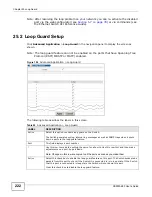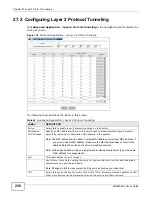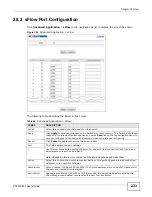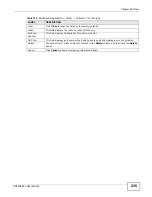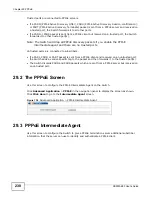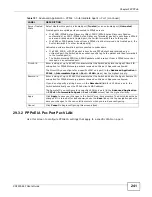
Chapter 27 Layer 2 Protocol Tunneling
XS3900-48F User’s Guide
231
STP
Select this option to have the Switch tunnel STP (Spanning Tree Protocol) packets so that
STP can run properly across the service provider’s network and spanning trees can be set
up based on bridge information from all (local and remote) networks.
VTP
Select this option to have the Switch tunnel VTP (VLAN Trunking Protocol) packets so that all
customer switches can use consistent VLAN configuration through the service provider’s
network.
Point to Point
The Switch supports PAgP (Port Aggregation Protocol), LACP (Link Aggregation Control
Protocol) and UDLD (UniDirectional Link Detection) tunneling for a point-to-point topology.
Both PAgP and UDLD are Cisco’s proprietary data link layer protocols. PAgP is similar to
LACP and used to set up a logical aggregation of Ethernet ports automatically. UDLD is to
determine the link’s physical status and detect a unidirectional link.
PAGP
Select this option to have the Switch send PAgP packets to a peer to automatically negotiate
and build a logical port aggregation.
LACP
Select this option to have the Switch send LACP packets to a peer to dynamically creates
and manages trunk groups.
UDLD
Select this option to have the Switch send UDLD packets to a peer’s port it connected to
monitor the physical status of a link.
Mode
Select Access to have the Switch encapsulate the incoming layer-2 protocol packets and
forward them to the tunnel port(s). Select Access for ingress ports at the edge of the
service provider's network.
Note: You can enable L2PT services for STP, LACP, VTP, CDP, UDLD, and PAGP on the
access port(s) only.
Select Tunnel for egress ports at the edge of the service provider's network. The Switch
decapsulates the encapsulated layer-2 protocol packets received on a tunnel port by
changing the destination MAC address to the original one, and then forward them to an
access port. If the service(s) is not enabled on an access port, the protocol packets are
dropped.
Apply
Click Apply to save your changes to the Switch’s run-time memory. The Switch loses these
changes if it is turned off or loses power, so use the Save link on the top navigation panel to
save your changes to the non-volatile memory when you are done configuring.
Cancel
Click Cancel to begin configuring this screen afresh.
Table 98
Advanced Application > Layer 2 Protocol Tunneling (continued)
LABEL
DESCRIPTION
Summary of Contents for XS-3900-48F
Page 15: ...15 PART I User s Guide ...
Page 16: ...16 ...
Page 48: ...Chapter 2 Tutorials XS3900 48F User s Guide 48 ...
Page 62: ...Chapter 4 The Web Configurator XS3900 48F User s Guide 62 ...
Page 63: ...63 PART II Technical Reference ...
Page 64: ...64 ...
Page 227: ...Chapter 26 VLAN Mapping XS3900 48F User s Guide 227 ...
Page 320: ...Appendix A Common Services XS3900 48F User s Guide 320 ...
Page 332: ...Index XS3900 48F User s Guide 332 ...






